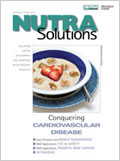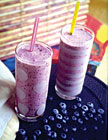

According to the American Heart Association (AHA), Cardiovascular Disease (CVD) has been the number-one cause of death in the U.S. in almost every year since 1900 (the exception was 1918, the year of the influenza epidemic). With the aging Baby Boomer population, experts project the death rate due to CVD will rise significantly over the next 10 years. Scientific evidence supporting the use of certain foods and ingredients for preventing CVD has accumulated to the point that, in the last 10 years, the FDA has allowed the addition of 14 new heart-related health claims. (See chart “Claims, Ingredients and Cardiovascular Health.”) These health claims provide a unique marketing advantage for heart-healthy products, as there is no other market category in condition-specific functional foods with so many allowed health claims. In addition, the AHA has a food certification program that uses the “heart checkmark” on foods that meet their nutritional requirements. Such “heart-healthy” labeling provides food manufacturers with an unambiguous message that consumers cannot miss when choosing heart-healthy products. Combine these marketing tools with a continuous flow of newly emerging scientific evidence on additional cardiovascular support from antioxidants, polyphenols and other phytonutrients from fruits and vegetables, and there has never been a better or easier time to formulate heart-healthy products.

Dietary Fiber, Whole Grains and Heart Disease
It has been close to 10 years since the FDA authorized the health claim that endorsed diets high in soluble fiber from certain foods, including psyllium and oats, for decreasing the risk of Coronary Heart Disease (CHD), one type of CVD. The most recent amendment to this claim is the addition of barley as a source of beta-glucans. New studies have shown that total cholesterol was significantly lowered when the diet contained 3-6g of beta-glucan per day from barley.1 For food formulators, this means that replacing refined grains in foods such as cereals or baked goods with barley flour or flakes can gain the CHD health claim. An avalanche of recent scientific studies also provides food formulators with reasons to formulate with other whole-grain ingredients, such as brown rice, whole wheat, buckwheat and quinoa. One large meta-analysis of seven studies of 285,000 men and women confirmed that 2.5 servings of whole grains each day can lower the risk of CHD by almost 25%.2 The use of whole grains also recently gained marketing boosts from two sources. First, the FDA issued a health claim (based on “authoritative statements”) that foods containing more than 51% whole grains can reduce the risk of heart disease and cancer. Second, the non-profit Whole Grains Council launched two Whole Grain Stamps that manufacturers can add to their packaging to help consumers identify products containing whole grains. The 100% Whole Grain Stamp can be used on products containing all whole grains and a full serving or more of whole grains in each labeled serving. The basic Whole Grain Stamp can be used on products containing at least half a serving of whole grains.

Phytosterols
Although no longer a newcomer to the scene, phytosterols continue to amass scientific evidence supporting their use for reducing the risk of CVD via their ability to block cholesterol absorption. In fact, recent reviews in both Lipids Journal and Nutritional Review emphasize that the potential cholesterol-lowering effect of phytosterols is underestimated, and they may actually have a greater impact than dietary fiber.3,4 Sterols and stanols, the two forms of phytosterols, are naturally found in certain fruits, vegetables, seeds, nuts, legumes and cereal grasses. The plant sterols found naturally in foods may occur either as free sterols, sterol/stanol esters (esterified with fatty acids) or sterol glucosides. A large review of clinical studies by the Mayo Clinic determined the maximum effective dose of phytosterol esters for lowering LDL cholesterol to be about 2g per day.5 Unfortunately, phytosterols are not naturally occurring in foods at levels that make it easy to obtain this dose without supplementation.6 Enter food industry officials, who not only figured out how to incorporate and deliver larger amounts of phytosterols into foods through esterification, but also successfully petitioned the FDA to approve the health claim. In its current form (21 CFR 101.83), the claim limits the type of food product to spreads, salad dressings, snack bars and supplements and requires the food to contain at least 0.65g of plant sterol esters or 1.7g of plant stanol esters. New clinical studies, however, have made it even easier to use phytosterols in functional foods by demonstrating that low-fat foods, such as yogurts, low-fat milk and orange juice, can also deliver effective doses of phytosterols.7,8,9 These studies were used to petition the FDA for extending the current health claim to include a broader range of food products, as well as allow the use of free-form sterols and stanols. The FDA’s response to this petition was to issue an interim health claim in 2003 that expanded the claim in these two areas as well as decreased the minimum addition to 400mg of free phytosterols per serving.

Nuts, Vegetable Oils and Omega-3s— Qualified Health Claims
In 2003, the FDA established the “Qualified Health Claim.” Similar to a Significant Scientific Agreement (SSA) claim, the Qualified Health Claim characterizes the relationship between a substance and a disease. However, the Qualified Claim does not meet the SSA standard for “significant scientific agreement” and, therefore, is accompanied by a disclaimer, usually by prefacing the claim with the words: “Supportive but not conclusive research shows…” The FDA has allowed six qualified claims pertaining to CVD, all of which are linked to increasing dietary intake of unsaturated fatty acids. However, in addition to the disclaimer, qualified health claims for nuts and vegetable oils have very stringent use rates and other nutrient requirements that must be met before the product can use the health claim.
The qualified health claim for omega-3 fatty acids, on the other hand, does not establish an “effective dietary intake” of eicosapentaenoic acid (EPA) and docosahexaenoic acid (DHA), the omega-3 fatty acids with well-documented beneficial effects on heart health. This means foods containing these omega-3s at any level can qualify for the health claim. Plus, due to recent advances in microencapsulation technology, the taste, odor and stability problems of incorporating fish oils into many food products may have been solved, allowing omega-3s to expand into new applications.
What's Next?
While the soluble fiber/CHD health claim also includes fiber from fruits and vegetables, it may only be a matter of time before other components of fruits or vegetables accrue enough scientific evidence to at least garner a Qualified Health Claim from the FDA. Some of the potential ingredients with compelling evidence already include lycopene and/or tomatoes (tomatoes already have a Qualified Health Claim for certain cancers), dietary flavonoids (such as anthocyanins from berries) and indoles from cruciferous vegetables. Other dietary polyphenols, such as those found in wine and chocolate, will unlikely ever have FDA-endorsed health claims. However, widespread media attention on these favorite vices has already turned these “bad habits” into a justifiable indulgence, even without the help of the FDA.
References:
1 Behall KM, et al. 2004. Diets containing barley significantly reduce lipids in mildly hypercholesterolemic men and women. Am J Clin Nutr. 80:1185-93.
2 Mellon PB, et al. 2007. Whole grain intake and cardiovascular disease: A meta-analysis. Nutrition, Metabolism and Cardiovascular Diseases. In Press.
3 Ellegard LH, et al. 2007. Dietary plant sterols and cholesterol metabolism. Nutrition Review. 65:39-45.
4 Ostlund RE, 2007. Phytosterols, cholesterol absorption and healthy diets. Lipids. 42:41-5.
5 Katan, MB, et al. 2003. Efficacy and safety of plant stanols and sterols in the management of blood cholesterol levels. Mayo Clinic Proceedings. 78:965-978.
6 Cater NB, et al. 1998. Lowering serum cholesterol with plant sterols and stanols: Historical perspectives. Journal of Postgraduate Medicine Special Report. 16-14.
7 Mensink RP, et al. 2002. Effects of plant stanol esters supplied in low-fat yoghurt on serum lipids and lipoproteins, non-cholesterol sterols and fat-soluble antioxidant concentrations. Atherosclerosis.160:205-213.
8 Noakes M, et al. 2005. Plant sterol ester-enriched milk and yoghurt effectively reduce serum cholesterol in modestly hypercholesterolemic subjects. Eur J Clin Nutr. 44:214-222.
Devaraj S, et al. 2004. Plant sterol-fortified orange juice effectively lowers cholesterol levels in mildly hypercholesterolemic healthy individuals. Arterioscler Thromb Vasc Biol. 24:e25-28.
HEART-HEALTH Claims